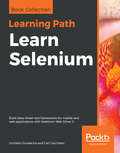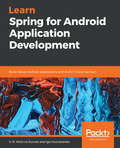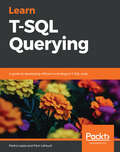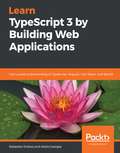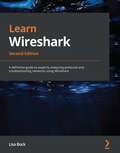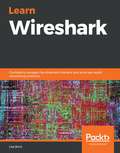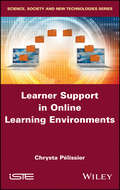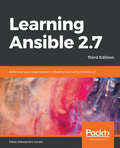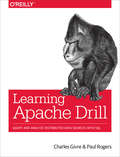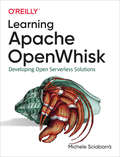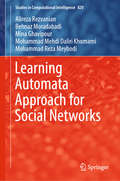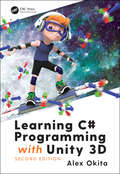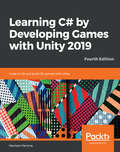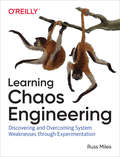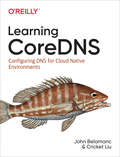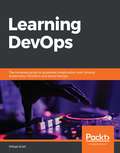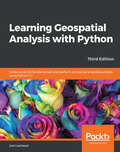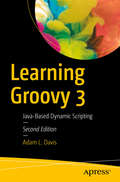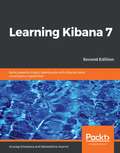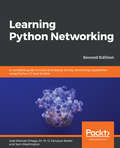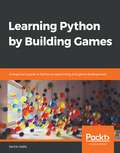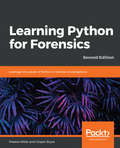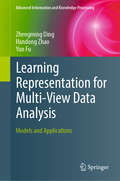- Table View
- List View
Learn Selenium: Build data-driven test frameworks for mobile and web applications with Selenium Web Driver 3
by Unmesh Gundecha Carl CocchiaroLearn end-to-end automation testing techniques for web and mobile browsers using Selenium WebDriver, AppiumDriver, Java, and TestNG Key Features Explore the Selenium grid architecture and build your own grid for browser and mobile devices Use ExtentReports for processing results and SauceLabs for cloud-based test services Unlock the full potential of Selenium to test your web applications. Book Description Selenium WebDriver 3.x is an open source API for testing both browser and mobile applications. With the help of this book, you can build a solid foundation and can easily perform end-to-end testing on web and mobile browsers.You'll begin by being introduced to the Selenium Page Object Model for software development. You'll architect your own framework with a scalable driver class, Java utility classes, and support for third-party tools and plugins. You'll design and build a Selenium grid from scratch to enable the framework to scale and support different browsers, mobile devices, and platforms.You'll strategize and handle a rich web UI using the advanced WebDriver API and learn techniques to handle real-time challenges in WebDriver. You'll perform different types of testing, such as cross-browser testing, load testing, and mobile testing. Finally, you will also be introduced to data-driven testing, using TestNG to create your own automation framework.By the end of this Learning Path, you'll be able to design your own automation testing framework and perform data-driven testing with Selenium WebDriver. This Learning Path includes content from the following Packt products: Selenium WebDriver 3 Practical Guide - Second Edition by Unmesh Gundecha Selenium Framework Design in Data-Driven Testing by Carl Cocchiaro What you will learn Use different mobile and desktop browser platforms with Selenium 3 Use the Actions API for performing various keyboard and mouse actions Design the Selenium Driver Class for local, remote, and third-party grid support Build page object classes with the Selenium Page Object Model Develop data-driven test classes using the TestNG framework Encapsulate data using the JSON protocol Build a Selenium Grid for RemoteWebDriver testing Build and use utility classes in synchronization, file I/O, reporting and test listener classes Who this book is for This Learning Path is ideal for software quality assurance/testing professionals, software project managers, or software developers interested in using Selenium for testing their applications. Professionals responsible for designing and building enterprise-based testing frameworks will also find this Learning Path useful. Prior programming experience in Java are TestNG is necessary.
Learn Spring for Android Application Development: Build robust Android applications with Kotlin 1.3 and Spring 5
by Igor Kucherenko S M SunnatAnyone who wants to learn how to use Spring to build Android apps. A basic knowledge of Spring will be helpful but not necessary.
Learn T-SQL Querying: A guide to developing efficient and elegant T-SQL code
by Pedro Lopes Pam LahoudTroubleshoot query performance issues, identify anti-patterns in code, and write efficient T-SQL queries Key Features Discover T-SQL functionalities and services that help you interact with relational databases Understand the roles, tasks and responsibilities of a T-SQL developer Explore solutions for carrying out database querying tasks, database administration, and troubleshooting Book Description Transact-SQL (T-SQL) is Microsoft's proprietary extension to the SQL language that is used with Microsoft SQL Server and Azure SQL Database. This book will be a useful guide to learning the art of writing efficient T-SQL code in modern SQL Server versions, as well as the Azure SQL Database. The book will get you started with query processing fundamentals to help you write powerful, performant T-SQL queries. You will then focus on query execution plans and learn how to leverage them for troubleshooting. In the later chapters, you will learn how to identify various T-SQL patterns and anti-patterns. This will help you analyze execution plans to gain insights into current performance, and determine whether or not a query is scalable. You will also learn to build diagnostic queries using dynamic management views (DMVs) and dynamic management functions (DMFs) to address various challenges in T-SQL execution. Next, you will study how to leverage the built-in tools of SQL Server to shorten the time taken to address query performance and scalability issues. In the concluding chapters, the book will guide you through implementing various features, such as Extended Events, Query Store, and Query Tuning Assistant using hands-on examples. By the end of this book, you will have the skills to determine query performance bottlenecks, avoid pitfalls, and discover the anti-patterns in use. Foreword by Conor Cunningham, Partner Architect – SQL Server and Azure SQL – Microsoft What you will learn Use Query Store to understand and easily change query performance Recognize and eliminate bottlenecks that lead to slow performance Deploy quick fixes and long-term solutions to improve query performance Implement best practices to minimize performance risk using T-SQL Achieve optimal performance by ensuring careful query and index design Use the latest performance optimization features in SQL Server 2017 and SQL Server 2019 Protect query performance during upgrades to newer versions of SQL Server Who this book is for This book is for database administrators, database developers, data analysts, data scientists, and T-SQL practitioners who want to get started with writing T-SQL code and troubleshooting query performance issues, through the help of practical examples. Previous knowledge of T-SQL querying is not required to get started on this book.
Learn TypeScript 3 by Building Web Applications: Gain a solid understanding of TypeScript, Angular, Vue, React, and NestJS
by Sebastien Dubois Alexis GeorgesLearn TypeScript and many of its features by building state of art web applications from scratch with the help of modern tooling, frameworks, and libraries Key Features Create modern Web applications to help businesses around the world benefit from better quality applications Learn the latest features of TypeScript 3 and use them wisely Explore TDD practices, OOP techniques, and industry best practices to create high-quality and modular apps Book Description TypeScript is a superset of the JavaScript programming language, giving developers a tool to help them write faster, cleaner JavaScript. With the help of its powerful static type system and other powerful tools and techniques it allows developers to write modern JavaScript applications. This book is a practical guide to learn the TypeScript programming language. It covers from the very basics to the more advanced concepts, while explaining many design patterns, techniques, frameworks, libraries and tools along the way. You will also learn a ton about modern web frameworks like Angular, Vue.js and React, and you will build cool web applications using those. This book also covers modern front-end development tooling such as Node.js, npm, yarn, Webpack, Parcel, Jest, and many others. Throughout the book, you will also discover and make use of the most recent additions of the language introduced by TypeScript 3 such as new types enforcing explicit checks, flexible and scalable ways of project structuring, and many more breaking changes. By the end of this book, you will be ready to use TypeScript in your own projects and will also have a concrete view of the current frontend software development landscape. What you will learn Understand and take advantage of TypeScript's powerful Type System Grasp the key concepts and features of Angular, React, Vue.js, and NestJS Handle asynchronous processes using Promises, async/await, Fetch, RxJS, and more Delve into REST, GraphQL and create APIs using Apollo Discover testing concepts, techniques, and tools like TDD, BDD, E2E, Jest Learn Object-Oriented and Functional Programming concepts and leverage those with TypeScript Explore design practices and patterns such as SOLID, MVC, DI and IoC, LoD, AOP, and more Who this book is for This book is for software developers who are willing to discover what TypeScript is and how to leverage it to write great quality software. Developers that are already familiar with TypeScript will find this book useful by learning the languages featured introduced by most recent releases. Basic knowledge of the JavaScript programming is expected.
Learn Wireshark: A definitive guide to expertly analyzing protocols and troubleshooting networks using Wireshark, 2nd Edition
by Lisa BockExpertly analyze common protocols such as TCP, IP, and ICMP, along with learning how to use display and capture filters, save and export captures, create IO and stream graphs, and troubleshoot latency issuesKey FeaturesGain a deeper understanding of common protocols so you can easily troubleshoot network issuesExplore ways to examine captures to recognize unusual traffic and possible network attacksLearn advanced techniques, create display and capture filters, and generate IO and stream graphsBook DescriptionWireshark is a popular and powerful packet analysis tool that helps network administrators investigate latency issues and potential attacks. Over the years, there have been many enhancements to Wireshark's functionality. This book will guide you through essential features so you can capture, display, and filter data with ease. In addition to this, you'll gain valuable tips on lesser-known configuration options, which will allow you to complete your analysis in an environment customized to suit your needs.This updated second edition of Learn Wireshark starts by outlining the benefits of traffic analysis. You'll discover the process of installing Wireshark and become more familiar with the interface. Next, you'll focus on the Internet Suite and then explore deep packet analysis of common protocols such as DNS, DHCP, HTTP, and ARP. The book also guides you through working with the expert system to detect network latency issues, create I/O and stream graphs, subset traffic, and save and export captures. Finally, you'll understand how to share captures using CloudShark, a browser-based solution for analyzing packet captures.By the end of this Wireshark book, you'll have the skills and hands-on experience you need to conduct deep packet analysis of common protocols and network troubleshooting as well as identify security issues.What you will learnMaster network analysis and troubleshoot anomalies with WiresharkDiscover the importance of baselining network trafficCorrelate the OSI model with frame formation in WiresharkNarrow in on specific traffic by using display and capture filtersConduct deep packet analysis of common protocols: IP, TCP, and ARPUnderstand the role and purpose ofICMP, DNS, HTTP, and DHCPCreate a custom configuration profile and personalize the interfaceCreate I/O and stream graphs to better visualize trafficWho this book is forIf you are a network administrator, security analyst, student, or teacher and want to learn about effective packet analysis using Wireshark, then this book is for you. In order to get the most from this book, you should have basic knowledge of network fundamentals, devices, and protocols along with an understanding of different topologies.
Learn Wireshark: Confidently navigate the Wireshark interface and solve real-world networking problems
by Lisa BockGrasp the basics of packet capture and analyze common protocols Key Features Troubleshoot basic to advanced network problems using packet analysis Analyze common protocols and identify latency issues with Wireshark Explore ways to examine captures to recognize unusual traffic and possible network attacks Book Description Wireshark is a popular and powerful packet analysis tool that helps network administrators investigate latency issues and identify potential attacks. Learn Wireshark provides a solid overview of basic protocol analysis and helps you to navigate the Wireshark interface, so you can confidently examine common protocols such as TCP, IP, and ICMP. The book starts by outlining the benefits of traffic analysis, takes you through the evolution of Wireshark, and then covers the phases of packet analysis. We'll review some of the command line tools and outline how to download and install Wireshark on either a PC or MAC. You'll gain a better understanding of what happens when you tap into the data stream, and learn how to personalize the Wireshark interface. This Wireshark book compares the display and capture filters and summarizes the OSI model and data encapsulation. You'll gain insights into the protocols that move data in the TCP/IP suite, and dissect the TCP handshake and teardown process. As you advance, you'll explore ways to troubleshoot network latency issues, and discover how to save and export files. Finally, you'll see how you can share captures with your colleagues using Cloudshark. By the end of this book, you'll have a solid understanding of how to monitor and secure your network with the most updated version of Wireshark. What you will learn Become familiar with the Wireshark interface Navigate commonly accessed menu options such as edit, view, and file Use display and capture filters to examine traffic Understand the Open Systems Interconnection (OSI) model Carry out deep packet analysis of the Internet suite: IP, TCP, UDP, ARP, and ICMP Explore ways to troubleshoot network latency issues Subset traffic, insert comments, save, export, and share packet captures Who this book is for This book is for network administrators, security analysts, students, teachers, and anyone interested in learning about packet analysis using Wireshark. Basic knowledge of network fundamentals, devices, and protocols along with an understanding of different topologies will be beneficial.
Learning Ansible 2.7: Automate your organization's infrastructure using Ansible 2.7, 3rd Edition
by Fabio Alessandro LocatiUse Ansible to configure your systems, deploy software, and orchestrate advanced IT tasksKey FeaturesGet familiar with the fundamentals of Ansible 2.7Understand how to use Ansible Tower to scale your IT automationGain insights into how to develop and test Ansible playbooks Book DescriptionAnsible is an open source automation platform that assists organizations with tasks such as application deployment, orchestration, and task automation. With the release of Ansible 2.7, even complex tasks can be handled much more easily than before.Learning Ansible 2.7 will help you take your first steps toward understanding the fundamentals and practical aspects of Ansible by introducing you to topics such as playbooks, modules, and the installation of Linux, Berkeley Software Distribution (BSD), and Windows support. In addition to this, you will focus on various testing strategies, deployment, and orchestration to build on your knowledge. The book will then help you get accustomed to features including cleaner architecture, task blocks, and playbook parsing, which can help you to streamline automation processes. Next, you will learn how to integrate Ansible with cloud platforms such as Amazon Web Services (AWS) before gaining insights into the enterprise versions of Ansible, Ansible Tower and Ansible Galaxy. This will help you to use Ansible to interact with different operating systems and improve your working efficiency. By the end of this book, you will be equipped with the Ansible skills you need to automate complex tasks for your organization.What you will learnCreate a web server using Ansible Write a custom module and test it Deploy playbooks in the production environment Troubleshoot networks using Ansible Use Ansible Galaxy and Ansible Tower during deployment Deploy an application with Ansible on AWS, Azure and DigitalOceanWho this book is forThis beginner-level book is for system administrators who want to automate their organization's infrastructure using Ansible 2.7. No prior knowledge of Ansible is required
Learning Apache Drill: Query and Analyze Distributed Data Sources with SQL
by Paul Rogers Charles GivreGet up to speed with Apache Drill, an extensible distributed SQL query engine that reads massive datasets in many popular file formats such as Parquet, JSON, and CSV. Drill reads data in HDFS or in cloud-native storage such as S3 and works with Hive metastores along with distributed databases such as HBase, MongoDB, and relational databases. Drill works everywhere: on your laptop or in your largest cluster.In this practical book, Drill committers Charles Givre and Paul Rogers show analysts and data scientists how to query and analyze raw data using this powerful tool. Data scientists today spend about 80% of their time just gathering and cleaning data. With this book, you’ll learn how Drill helps you analyze data more effectively to drive down time to insight.Use Drill to clean, prepare, and summarize delimited data for further analysisQuery file types including logfiles, Parquet, JSON, and other complex formatsQuery Hadoop, relational databases, MongoDB, and Kafka with standard SQLConnect to Drill programmatically using a variety of languagesUse Drill even with challenging or ambiguous file formatsPerform sophisticated analysis by extending Drill’s functionality with user-defined functionsFacilitate data analysis for network security, image metadata, and machine learning
Learning Apache OpenWhisk: Developing Open Serverless Solutions
by Michele SciabarràServerless computing greatly simplifies software development. Your team can focus solely on your application while the cloud provider manages the servers you need. This practical guide shows you step-by-step how to build and deploy complex applications in a flexible multicloud, multilanguage environment using Apache OpenWhisk. You’ll learn how this platform enables you to pursue a vendor-independent approach using preconfigured containers, microservices, and Kubernetes as your cloud operating system.Michele Sciabarrà demonstrates how to build a serverless application using classical design patterns and the programming language or languages that best fit your task. You’ll start by building a simple serverless application hands-on before diving into the more complex aspects of the OpenWhisk platform.Examine how OpenWhisk’s serverless architecture works, including the use of packages, actions, sequences, triggers, rules, and feedsLearn how OpenWhisk compares to existing architectures, such as Java Enterprise EditionManipulate OpenWhisk features using the command-line interface or a JavaScript APIDesign applications using common Gang of Four design patternsUse architectural design patterns such as model-view-controller to combine several OpenWhisk actionsLearn how to test and debug your code in a serverless environment
Learning Automata Approach for Social Networks (Studies in Computational Intelligence #820)
by Alireza Rezvanian Mohammad Reza Meybodi Behnaz Moradabadi Mina Ghavipour Mohammad Mehdi Daliri KhomamiThis book begins by briefly explaining learning automata (LA) models and a recently developed cellular learning automaton (CLA) named wavefront CLA. Analyzing social networks is increasingly important, so as to identify behavioral patterns in interactions among individuals and in the networks’ evolution, and to develop the algorithms required for meaningful analysis. As an emerging artificial intelligence research area, learning automata (LA) has already had a significant impact in many areas of social networks. Here, the research areas related to learning and social networks are addressed from bibliometric and network analysis perspectives. In turn, the second part of the book highlights a range of LA-based applications addressing social network problems, from network sampling, community detection, link prediction, and trust management, to recommender systems and finally influence maximization. Given its scope, the book offers a valuable guide for all researchers whose work involves reinforcement learning, social networks and/or artificial intelligence.
Learning C# Programming with Unity 3D, second edition
by Alex OkitaLearning C# Programming with Unity 3D, Second Edition is for the novice game programmer without any prior programming experience. Readers will learn how C# is used to make a game in Unity 3D. Many example projects provide working code to learn from and experiment with. As C# evolves, Unity 3D evolves along with it. Many new features and aspects of C# are included and explained. Common programming tasks are taught by way of making working game mechanics. The reader will understand how to read and apply C# in Unity 3D and apply that knowledge to other development environments that use C#. New to this edition: includes latest C# language features and useful tools included with the .NET library like LINQ, Local Functions Tuples, and more! Key Features Provides a starting point for the first-time programmer C# Code examples are simple short and clear Learn the very basics on up to interesting tricks which C# offers
Learning C# by Developing Games with Unity 2019: Code in C# and build 3D games with Unity, 4th Edition
by Harrison FerroneUnderstand the fundamentals of C# programming and get started with coding from ground up in an engaging and practical mannerKey FeaturesBeginner's guide to getting started with software development concepts from a macro levelLeverage the power of the latest C# in solving the complex programming problemsLearn to script and customize your 3D games and implement animation techniques to make them engagingBook DescriptionLearning to program in today's technical landscape can be a daunting task, especially when faced with the sheer number of languages you have to choose from. Luckily, Learning C# with Unity 2019 removes the guesswork and starts you off on the path to becoming a confident, and competent, programmer using game development with Unity.You'll start off small by learning the building blocks of programming, from variables, methods, and conditional statements to classes and object-oriented systems. After you have the basics under your belt you'll explore the Unity interface, creating C# scripts, and translating your newfound knowledge into simple game mechanics.Throughout this journey, you'll get hands-on experience with programming best practices and macro-level topics such as manager classes and flexible application architecture. By the end of the book, you'll be familiar with intermediate C# topics like generics, delegates, and events, setting you up to take on projects of your own.What you will learnUnderstand programming fundamentals with practice examples in C#Explore the interface and features of Unity 2019Learn C# programming syntax from scratchCreate a game design document and prototype levelExplore intermediate programming topics and best practicesImplement game mechanics, interactions, and UI elements with C#Who this book is forThe book caters to developers and programmers who want to get started with C# programming in a fun and engaging manner. Anyone who wants to build games and script in C# language and Unity can take this book up. No prior programming or Unity experience is required.
Learning Chaos Engineering: Discovering and Overcoming System Weaknesses Through Experimentation
by Russ MilesMost companies work hard to avoid costly failures, but in complex systems a better approach is to embrace and learn from them. Through chaos engineering, you can proactively hunt for evidence of system weaknesses before they trigger a crisis. This practical book shows software developers and system administrators how to plan and run successful chaos engineering experiments.System weaknesses go beyond your infrastructure, platforms, and applications to include policies, practices, playbooks, and people. Author Russ Miles explains why, when, and how to test systems, processes, and team responses using simulated failures on Game Days. You’ll also learn how to work toward continuous chaos through automation with features you can share across your team and organization.Learn to think like a chaos engineerBuild a hypothesis backlog to determine what could go wrong in your systemDevelop your hypotheses into chaos engineering experiment Game DaysWrite, run, and learn from automated chaos experiments using the open source Chaos ToolkitTurn chaos experiments into tests to confirm that you’ve overcome the weaknesses you discoveredObserve and control your automated chaos experiments while they are running
Learning CoreDNS: Configuring DNS for Cloud Native Environments
by Cricket Liu John BelamaricUntil recently, learning CoreDNS required reading the code or combing through the skimpy documentation on the website. No longer. With this practical book, developers and operators working with Docker or Linux containers will learn how to use this standard DNS server with Kubernetes.John Belamaric, senior staff software engineer at Google, and Cricket Liu, chief DNS architect at Infoblox, show you how to configure CoreDNS using real-world configuration examples to achieve specific purposes. You’ll learn the basics of DNS, including how it functions as a location broker in container environments and how it ties into Kubernetes.Dive into DNS theory: the DNS namespace, domain names, domains, and zonesLearn how to configure your CoreDNS serverManage and serve basic and advanced zone data with CoreDNSConfigure CoreDNS service discovery with etcd and KubernetesLearn one of the most common use cases for CoreDNS: the integration with KubernetesManipulate queries and responses as they flow through the plug-in chainMonitor and troubleshoot the availability and performance of your DNS serviceBuild custom versions of CoreDNS and write your own plug-ins
Learning DevOps: The complete guide to accelerate collaboration with Jenkins, Kubernetes, Terraform and Azure DevOps
by Mikael KriefSimplify your DevOps roles with DevOps tools and techniques Key Features Learn to utilize business resources effectively to increase productivity and collaboration Leverage the ultimate open source DevOps tools to achieve continuous integration and continuous delivery (CI/CD) Ensure faster time-to-market by reducing overall lead time and deployment downtime Book Description The implementation of DevOps processes requires the efficient use of various tools, and the choice of these tools is crucial for the sustainability of projects and collaboration between development (Dev) and operations (Ops). This book presents the different patterns and tools that you can use to provision and configure an infrastructure in the cloud. You'll begin by understanding DevOps culture, the application of DevOps in cloud infrastructure, provisioning with Terraform, configuration with Ansible, and image building with Packer. You'll then be taken through source code versioning with Git and the construction of a DevOps CI/CD pipeline using Jenkins, GitLab CI, and Azure Pipelines. This DevOps handbook will also guide you in containerizing and deploying your applications with Docker and Kubernetes. You'll learn how to reduce deployment downtime with blue-green deployment and the feature flags technique, and study DevOps practices for open source projects. Finally, you'll grasp some best practices for reducing the overall application lead time to ensure faster time to market. By the end of this book, you'll have built a solid foundation in DevOps, and developed the skills necessary to enhance a traditional software delivery process using modern software delivery tools and techniques What you will learn Become well versed with DevOps culture and its practices Use Terraform and Packer for cloud infrastructure provisioning Implement Ansible for infrastructure configuration Use basic Git commands and understand the Git flow process Build a DevOps pipeline with Jenkins, Azure Pipelines, and GitLab CI Containerize your applications with Docker and Kubernetes Check application quality with SonarQube and Postman Protect DevOps processes and applications using DevSecOps tools Who this book is for If you are a developer or a system administrator interested in understanding continuous integration, continuous delivery, and containerization with DevOps tools and techniques, this book is for you.
Learning Elastic Stack 7.0: Distributed search, analytics, and visualization using Elasticsearch, Logstash, Beats, and Kibana, 2nd Edition
by Pranav Shukla Sharath Kumar M NA beginner's guide to storing, managing, and analyzing data with the updated features of Elastic 7.0Key FeaturesGain access to new features and updates introduced in Elastic Stack 7.0Grasp the fundamentals of Elastic Stack including Elasticsearch, Logstash, and KibanaExplore useful tips for using Elastic Cloud and deploying Elastic Stack in production environmentsBook DescriptionThe Elastic Stack is a powerful combination of tools for techniques such as distributed search, analytics, logging, and visualization of data. Elastic Stack 7.0 encompasses new features and capabilities that will enable you to find unique insights into analytics using these techniques. This book will give you a fundamental understanding of what the stack is all about, and help you use it efficiently to build powerful real-time data processing applications.The first few sections of the book will help you understand how to set up the stack by installing tools, and exploring their basic configurations. You’ll then get up to speed with using Elasticsearch for distributed searching and analytics, Logstash for logging, and Kibana for data visualization. As you work through the book, you will discover the technique of creating custom plugins using Kibana and Beats. This is followed by coverage of the Elastic X-Pack, a useful extension for effective security and monitoring. You’ll also find helpful tips on how to use Elastic Cloud and deploy Elastic Stack in production environments. By the end of this book, you’ll be well versed with the fundamental Elastic Stack functionalities and the role of each component in the stack to solve different data processing problems.What you will learnInstall and configure an Elasticsearch architectureSolve the full-text search problem with ElasticsearchDiscover powerful analytics capabilities through aggregations using ElasticsearchBuild a data pipeline to transfer data from a variety of sources into Elasticsearch for analysisCreate interactive dashboards for effective storytelling with your data using KibanaLearn how to secure, monitor and use Elastic Stack’s alerting and reporting capabilitiesTake applications to an on-premise or cloud-based production environment with Elastic StackWho this book is forThis book is for entry-level data professionals, software engineers, e-commerce developers, and full-stack developers who want to learn about Elastic Stack and how the real-time processing and search engine works for business analytics and enterprise search applications. Previous experience with Elastic Stack is not required, however knowledge of data warehousing and database concepts will be helpful.
Learning Geospatial Analysis with Python: Understand GIS fundamentals and perform remote sensing data analysis using Python 3.7, 3rd Edition
by Joel LawheadLearn the core concepts of geospatial data analysis for building actionable and insightful GIS applications Key Features Create GIS solutions using the new features introduced in Python 3.7 Explore a range of GIS tools and libraries such as PostGIS, QGIS, and PROJ Learn to automate geospatial analysis workflows using Python and Jupyter Book Description Geospatial analysis is used in almost every domain you can think of, including defense, farming, and even medicine. With this systematic guide, you'll get started with geographic information system (GIS) and remote sensing analysis using the latest features in Python. This book will take you through GIS techniques, geodatabases, geospatial raster data, and much more using the latest built-in tools and libraries in Python 3.7. You'll learn everything you need to know about using software packages or APIs and generic algorithms that can be used for different situations. Furthermore, you'll learn how to apply simple Python GIS geospatial processes to a variety of problems, and work with remote sensing data. By the end of the book, you'll be able to build a generic corporate system, which can be implemented in any organization to manage customer support requests and field support personnel. What you will learn Automate geospatial analysis workflows using Python Code the simplest possible GIS in just 60 lines of Python Create thematic maps with Python tools such as PyShp, OGR, and the Python Imaging Library Understand the different formats that geospatial data comes in Produce elevation contours using Python tools Create flood inundation models Apply geospatial analysis to real-time data tracking and storm chasing Who this book is for This book is for Python developers, researchers, or analysts who want to perform geospatial modeling and GIS analysis with Python. Basic knowledge of digital mapping and analysis using Python or other scripting languages will be helpful.
Learning Groovy 3: Java-Based Dynamic Scripting
by Adam L. DavisStart building powerful apps that take advantage of the dynamic scripting capabilities of the Groovy language, including what's new in Groovy version 3.0. This book covers Groovy fundamentals, such as installing Groovy, using Groovy tools, and working with the Groovy Development Kit (GDK). You'll also learn more advanced aspects of Groovy, such as using Groovy design patterns, writing DSLs in Groovy, and taking advantage of Groovy's functional programming features.Also, Learning Groovy 3 has been updated to Groovy 3.0 to include the new Parrot parser which was extended to support additional syntax options and language features. It also includes coverage of Groovydoc, which allows you to embed Groovydoc comments in various ways. And, this book covers how Groovy supports Java type annotations and more.There is more to Groovy than the core language, so Learning Groovy 3, Second Edition covers the extended Groovy ecosystem. You'll see how to harness Gradle (Groovy's build system), Grails (Groovy's web application framework), Spock (Groovy's testing framework), and Ratpack (Groovy's reactive web library).What You Will LearnGrasp Groovy fundamentals, including the GDK Master advanced Groovy, such as writing Groovy DSLsDiscover functional programming in GroovyWork with GPars, the built-in concurrency libraryUse Gradle, the build systemMaster Grails, the web application frameworkWork with Spock, the testing frameworkHarness Ratpack, the reactive web libraryWho This Book Is ForThose with a Java background, though anyone with basic programming skills can benefit from it. This book is a data-filled, yet easy-to-digest tour of the Groovy language and ecosystem.
Learning Kibana 7: Build powerful Elastic dashboards with Kibana's data visualization capabilities, 2nd Edition
by Bahaaldine Azarmi Anurag SrivastavaA beginner's guide to analyzing and visualizing your Elasticsearch data using Kibana 7 and Timelion Key Features Gain a fundamental understanding of how Kibana operates within the Elastic Stack Explore your data with Elastic Graph and create rich dashboards in Kibana Learn scalable data visualization techniques in Kibana 7 Book Description Kibana is a window into the Elastic Stack, that enables the visual exploration and real-time analysis of your data in Elasticsearch. This book will help you understand the core concepts of the use of Kibana 7 for rich analytics and data visualization. If you're new to the tool or want to get to grips with the latest features introduced in Kibana 7, this book is the perfect beginner's guide. You'll learn how to set up and configure the Elastic Stack and understand where Kibana sits within the architecture. As you advance, you'll learn how to ingest data from different sources using Beats or Logstash into Elasticsearch, followed by exploring and visualizing data in Kibana. Whether working with time series data to create complex graphs using Timelion or embedding visualizations created in Kibana into your web applications, this book covers it all. It also covers topics that every Elastic developer needs to be aware of, such as installing and configuring Application Performance Monitoring (APM) servers and agents. Finally, you'll also learn how to create effective machine learning jobs in Kibana to find anomalies in your data. By the end of this book, you'll have a solid understanding of Kibana, and be able to create your own visual analytics solutions from scratch. What you will learn Explore the data-driven architecture of the Elastic Stack Install and set up Kibana 7 and other Elastic Stack components Use Beats and Logstash to get input from different data sources Create different visualizations using Kibana Build enterprise-grade Elastic dashboards from scratch Use Timelion to play with time series data Install and configure APM servers and APM agents Work with Dev Tools, Spaces, Graph, and other important tools Who this book is for If you're an aspiring Elastic developer or data analysts, this book is for you. You'll also find it useful if you want to get up to speed with the new features of Kibana 7 and perform data visualization on enterprise data. No prior knowledge of Kibana is expected, but some experience with Elasticsearch will be helpful.
Learning PostgreSQL 11: A beginner's guide to building high-performance PostgreSQL database solutions, 3rd Edition
by Salahaldin Juba Andrey VolkovLeverage the power of PostgreSQL 11 to build powerful database and data warehousing applications Key Features Monitor, secure, and fine-tune your PostgreSQL 11 database Learn client-side and server-side programming using SQL and PL/pgSQL Discover tips on implementing efficient database solutions Book Description PostgreSQL is one of the most popular open source database management systems in the world, and it supports advanced features included in SQL standards. This book will familiarize you with the latest features in PostgreSQL 11, and get you up and running with building efficient PostgreSQL database solutions from scratch. Learning PostgreSQL, 11 begins by covering the concepts of relational databases and their core principles. You'll explore the Data Definition Language (DDL) and commonly used DDL commands supported by ANSI SQL. You'll also learn how to create tables, define integrity constraints, build indexes, and set up views and other schema objects. As you advance, you'll come to understand Data Manipulation Language (DML) and server-side programming capabilities using PL/pgSQL, giving you a robust background to develop, tune, test, and troubleshoot your database application. The book will guide you in exploring NoSQL capabilities and connecting to your database to manipulate data objects. You'll get to grips with using data warehousing in analytical solutions and reports, and scaling the database for high availability and performance. By the end of this book, you'll have gained a thorough understanding of PostgreSQL 11 and developed the necessary skills to build efficient database solutions. What you will learn Understand the basics of relational databases, relational algebra, and data modeling Install a PostgreSQL server, create a database, and implement your data model Create tables and views, define indexes and stored procedures, and implement triggers Make use of advanced data types such as Arrays, hstore, and JSONB Connect your Python applications to PostgreSQL and work with data efficiently Identify bottlenecks to enhance reliability and performance of database applications Who this book is for This book is for you if you're interested in learning about PostgreSQL from scratch. Those looking to build solid database or data warehousing applications or wanting to get up to speed with the latest features of PostgreSQL 11 will also find this book useful. No prior knowledge of database programming or administration is required to get started.
Learning Python Networking: A complete guide to build and deploy strong networking capabilities using Python 3.7 and Ansible , 2nd Edition
by Sam Washington Jose Manuel Ortega Dr. M. SarkerAchieve improved network programmability and automation by leveraging powerful network programming concepts, algorithms, and tools Key Features Deal with remote network servers using SSH, FTP, SNMP and LDAP protocols. Design multi threaded and event-driven architectures for asynchronous servers programming. Leverage your Python programming skills to build powerful network applications Book Description Network programming has always been a demanding task. With full-featured and well-documented libraries all the way up the stack, Python makes network programming the enjoyable experience it should be. Starting with a walk through of today's major networking protocols, through this book, you'll learn how to employ Python for network programming, how to request and retrieve web resources, and how to extract data in major formats over the web. You will utilize Python for emailing using different protocols, and you'll interact with remote systems and IP and DNS networking. You will cover the connection of networking devices and configuration using Python 3.7, along with cloud-based network management tasks using Python. As the book progresses, socket programming will be covered, followed by how to design servers, and the pros and cons of multithreaded and event-driven architectures. You'll develop practical clientside applications, including web API clients, email clients, SSH, and FTP. These applications will also be implemented through existing web application frameworks. What you will learn Execute Python modules on networking tools Automate tasks regarding the analysis and extraction of information from a network Get to grips with asynchronous programming modules available in Python Get to grips with IP address manipulation modules using Python programming Understand the main frameworks available in Python that are focused on web application Manipulate IP addresses and perform CIDR calculations Who this book is for If you're a Python developer or a system administrator with Python experience and you're looking to take your first steps in network programming, then this book is for you. If you're a network engineer or a network professional aiming to be more productive and efficient in networking programmability and automation then this book would serve as a useful resource. Basic knowledge of Python is assumed.
Learning Python by Building Games: A beginner's guide to Python programming and game development
by Sachin KafleExplore modern game development and programming techniques to build games using Python and its popular libraries such as Pygame and PyOpenGL Key Features Learn game development and Python through a practical, example-driven approach Discover a variety of game development techniques to build games that gradually increase in complexity Leverage popular Python gaming libraries such as Pygame, PyOpenGL, Pymunk, and Pyglet Book Description A fun and interactive way to get started with the Python language and its libraries is by getting hands-on with game development. Learning Python by Building Games brings you the best of both worlds. The book will first introduce you to Python fundamentals, which you will then use to develop a basic game. You'll gradually explore the different Python libraries best suited for game development such as Pygame, Pyglet, and PyOpenGL. From building game characters through to using 3D animation techniques, you'll discover how to create an aesthetic game environment. In addition to this, you'll focus on game physics to give your effects a realistic feel, complete with movements and collisions. The book will also cover how you can use particle systems to simulate phenomena such as an explosion or smoke. In later chapters, you will gain insights into object-oriented programming by modifying a snake game, along with exploring GUI programming to build a user interface with Python's turtle module. By the end of this book, you'll be well-versed with Python programming concepts and popular libraries, and have the confidence to build your own games What you will learn Explore core Python concepts by understanding Python libraries Build your first 2D game using Python scripting Understand concepts such as decorators and properties in the Python ecosystem Create animations and movements by building a Flappy Bird-like game Design game objects and characters using Pygame, PyOpenGL, and Pymunk Add intelligence to your gameplay by incorporating game artificial intelligence (AI) techniques using Python Who this book is for If you are completely new to Python or game programming and want to develop your programming skills, then this book is for you. The book also acts as a refresher for those who already have experience of using Python and want to learn how to build exciting games.
Learning Python for Forensics - Second Edition: Leverage the power of Python in forensic investigations, 2nd Edition
by Preston Miller Chapin BryceIf you are a forensics student, hobbyist, or professional that is seeking to increase your understanding in forensics through the use of a programming language, then this book is for you. You are not required to have previous experience in programming to learn and master the content within this book. This material, created by forensic professionals, was written with a unique perspective and understanding of examiners who wish to learn programming
Learning Representation for Multi-View Data Analysis: Models and Applications (Advanced Information and Knowledge Processing)
by Yun Fu Zhengming Ding Handong ZhaoThis book equips readers to handle complex multi-view data representation, centered around several major visual applications, sharing many tips and insights through a unified learning framework. This framework is able to model most existing multi-view learning and domain adaptation, enriching readers’ understanding from their similarity, and differences based on data organization and problem settings, as well as the research goal. A comprehensive review exhaustively provides the key recent research on multi-view data analysis, i.e., multi-view clustering, multi-view classification, zero-shot learning, and domain adaption. More practical challenges in multi-view data analysis are discussed including incomplete, unbalanced and large-scale multi-view learning. Learning Representation for Multi-View Data Analysis covers a wide range of applications in the research fields of big data, human-centered computing, pattern recognition, digital marketing, web mining, and computer vision.
